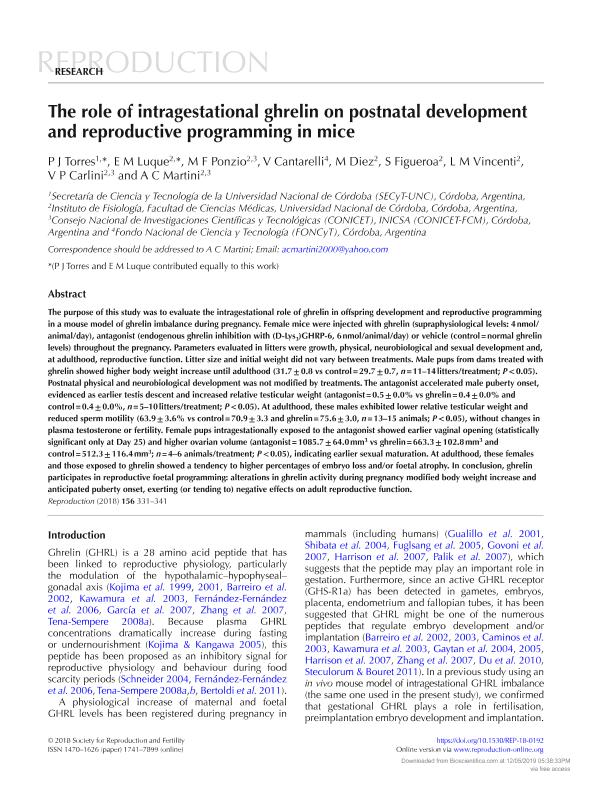Artículo
The role of intragestational ghrelin on postnatal development and reproductive programming in mice
Torres, Pedro Javier; Luque, Eugenia Mercedes ; Ponzio, Marina Flavia
; Ponzio, Marina Flavia ; Cantarelli, Verónica Inés; Diez, Marcela
; Cantarelli, Verónica Inés; Diez, Marcela ; Figueroa, S.; Vincenti, Laura María; Carlini, Valeria Paola
; Figueroa, S.; Vincenti, Laura María; Carlini, Valeria Paola ; Martini, Ana Carolina
; Martini, Ana Carolina
 ; Ponzio, Marina Flavia
; Ponzio, Marina Flavia ; Cantarelli, Verónica Inés; Diez, Marcela
; Cantarelli, Verónica Inés; Diez, Marcela ; Figueroa, S.; Vincenti, Laura María; Carlini, Valeria Paola
; Figueroa, S.; Vincenti, Laura María; Carlini, Valeria Paola ; Martini, Ana Carolina
; Martini, Ana Carolina
Fecha de publicación:
05/2018
Editorial:
BioScientifica
Revista:
Reproduction
ISSN:
1470-1626
Idioma:
Inglés
Tipo de recurso:
Artículo publicado
Clasificación temática:
Resumen
The purpose of this study was to evaluate the intragestational role of ghrelin in offspring development and reproductive programming in a mouse model of ghrelin imbalance during pregnancy. Female mice were injected with ghrelin (supraphysiological levels: 4 nmol/animal/day), antagonist (endogenous ghrelin inhibition with (D-Lys3)GHRP-6, 6 nmol/animal/day) or vehicle (control = normal ghrelin levels) throughout the pregnancy. Parameters evaluated in litters were growth, physical, neurobiological and sexual development and, at adulthood, reproductive function. Litter size and initial weight did not vary between treatments. Male pups from dams treated with ghrelin showed higher body weight increase until adulthood (31.7 ± 0.8 vs control = 29.7 ± 0.7, n = 11-14 litters/treatment; P < 0.05). Postnatal physical and neurobiological development was not modified by treatments. The antagonist accelerated male puberty onset, evidenced as earlier testis descent and increased relative testicular weight (antagonist = 0.5 ± 0.0% vs ghrelin = 0.4 ± 0.0% and control = 0.4 ± 0.0%, n = 5-10 litters/treatment; P < 0.05). At adulthood, these males exhibited lower relative testicular weight and reduced sperm motility (63.9 ± 3.6% vs control = 70.9 ± 3.3 and ghrelin = 75.6 ± 3.0, n = 13-15 animals; P < 0.05), without changes in plasma testosterone or fertility. Female pups intragestationally exposed to the antagonist showed earlier vaginal opening (statistically significant only at Day 25) and higher ovarian volume (antagonist = 1085.7 ± 64.0 mm3 vs ghrelin = 663.3 ± 102.8 mm3 and control = 512.3 ± 116.4 mm3; n = 4-6 animals/treatment; P < 0.05), indicating earlier sexual maturation. At adulthood, these females and those exposed to ghrelin showed a tendency to higher percentages of embryo loss and/or foetal atrophy. In conclusion, ghrelin participates in reproductive foetal programming: Alterations in ghrelin activity during pregnancy modified body weight increase and anticipated puberty onset, exerting (or tending to) negative effects on adult reproductive function.
Palabras clave:
GHRELIN
,
(D-Lys 3)GHRP-6
,
FETAL PROGRAMMING
,
REPRODUCTIVE PROGRAMMING
Archivos asociados
Licencia
Identificadores
Colecciones
Articulos(INICSA)
Articulos de INSTITUTO DE INVESTIGACIONES EN CIENCIAS DE LA SALUD
Articulos de INSTITUTO DE INVESTIGACIONES EN CIENCIAS DE LA SALUD
Citación
Torres, Pedro Javier; Luque, Eugenia Mercedes; Ponzio, Marina Flavia; Cantarelli, Verónica Inés; Diez, Marcela; et al.; The role of intragestational ghrelin on postnatal development and reproductive programming in mice; BioScientifica; Reproduction; 156; 4; 5-2018; 331-351
Compartir
Altmétricas



